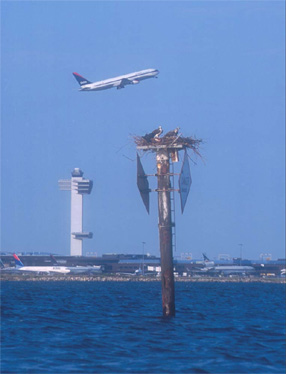

• Intro / Home
• Historical Neighbors
• Street and Backyard
Neighbors
• Park and Green Places
Neighbors
• Shore and Wetlands
Neighbors
• Salt and Freshwater
Neighbors
• Tiny Neighbors
• Unwelcome Neighbors
• Occasional and
Unexpected Neighbors
•
Wildlife Sighting Log
• Resources
• Hours and Tours
• Press Release
• NYPL HOME
| Shore and Wetlands Neighbors | |
These Ospreys are nesting on one of seven platforms erected for their use at Jamaica Bay Wildlife Refuge. Although five nests were occupied during 2002, just three were visible to visitors to the enormous federal refuge, which encompasses 9,000 acres of the Bay, marshlands, islands and mudflats, ponds, beaches, natural gardens, and uplands. The proximity of the enormous airport evidently does not intimidate the approximately 325 species of resident and visiting birds recorded at the Refuge. Ospreys suffered near-disastrous population declines
beginning in the 1940s because the widely used toxic insecticide
DDT contaminated the fish that the birds fed on, and so weakened
the eggshells that most did not hatch. DDT was banned in 1972, and
the population of the magnificent hawks has slowly increased,monitored
and aided by governmental and environmental gencies.
|
